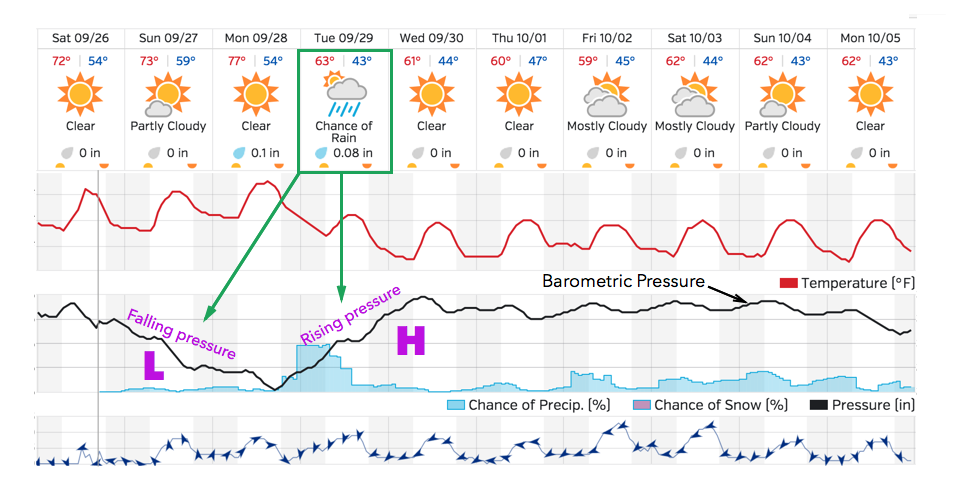Barometric pressure and deer movement
In this post we walk you through what exactly barometric pressure is how it impacts deer movement.
What is barometric pressure?
If you have watched the weather before, you’ve heard meteorologists refer to low and high pressure systems moving across the country as seen in the graphic above. The high and the low pressure they are referring to is the barometric pressure, also known as the “atmospheric pressure.” This pressure is a measurement of the amount of mass over a given area. Low pressure systems have less atmospheric mass whereas a high pressure system has more. This mass can also be thought of as the density of air molecules within the system.
So why is this important to understand and monitor? As deer hunters, we know that changes to the weather get deer on their feet. The reason pressure is important to monitor is that it serves as an indicator to what the weather is going to do. We can monitor the trending pressure changes to get a better idea of what days are best to be in the woods. It’s all about hunting smarter, not harder.
Why does the pressure change?
The barometric pressure, or the mass above a given area, changes with the weather. Below we break down low and high pressure systems and how they relate to changing weather patterns.
Low pressure system
A low pressure system is associated with a falling barometer. When the barometer is decreasing, the air molecules above the earth’s surface are not as compact. As a result, low pressure systems are known to bring in weather fronts such as clouds, rain and snow. This is critical to remember.
High pressure system
Alternatively, a high pressure system results in a rising barometer. This happens when the air molecules are more compressed. It’s important to remember here that the pressure generally rises after a storm has moved through an area.
The below graphic is from the website of my favorite weather monitoring tool Wunderground. You can use Wunderground on your computer or phone, and it has some of the best hunter friendly weather forecasting tools out there. It gives you a great forward looking view so that you can better plan which days you want to be out hunting.
I doctored up the below graphic with some arrows to illustrate the above point of the pressure changing and the resulting weather patterns. Notice the decline in pressure starting Sunday and the resulting rainstorm on Tuesday. The pressure then climbs again following the rainstorm. As hunters we want to key in on these weather fronts, and by studying the trends in the pressure changes we can get a good read on what is going to happen with the weather.
How to use barometric pressure to pick your hunting days
Like we said above, pressure is an indicator. So let’s use that to help plan our hunting strategy to make sure we’re in the stand at the most optimal times throughout the season, sticking with the theme of hunting smarter and not just harder.
In general, you want to hunt the rising and falling barometers because that means the weather is changing. If the pressure is trending flat you can expect the weather to hold, which does not make for the most optimal hunting conditions. Most of us don’t have the freedom to hunt everyday which means we need to choose our days wisely in order to increase our chances of tagging a mature buck. This is why it’s important to key in on these changes in pressure.
Mark Drury, of Drury Outdoors, was recently on the Wired To Hunt Podcast and shared that his personal favorite time to hunt is when there is a rising barometer immediately following a storm. He comments that the action is the best on that first day of a high pressure system following a hard rain or a blizzard. The days succeeding the storm will still be good, but the activity diminishes over time. If you haven’t already, definitely go check out The Wired To Hunt Podcast with Mark Drury. It’s packed with tons of great information on how to use the weather to your advantage.
Hunting a dropping barometer can also be an effective strategy before a storm hits. When you see that barometric pressure trending down, as seen in the below graphic, you can expect some sort of front to be moving in, and that too can be a great time to see deer on their feet.
By studying the pressure over time, you can begin to build an understanding of where the pressure usually sits in your area. As mentioned above, Wunderground is a fantastic resource for studying how the pressure is changing across your various hunting spots.
Another way to monitor the pressure and gain an understanding of what type of pressure gets deer moving in your area is to use the The Quiver Hunting App. The app provides the current pressure and trend when you track your hunts using the app. This can be extremely useful information over time as you start to build a more complete understanding of how the weather impacts deer movement.
Targeting mature whitetails is no easy feat. As hunters we need to try and stack the odds in our favor, and one way to do this is to use the weather to our advantage. Studying the barometric pressure is one piece to the puzzle when it comes to setting yourself up for sweet sweet success.
Try the Quiver Hunting App today



